
Romance, 12 Chapters, 1934. Starring Bobby Cox, Jim Vance, Carter Dixon, Philo McCullough.
Boy Scouts Bobby Ford (Bobby Cox) and Jim Adams (Jim Vance) are cited (respectively) for valor and high attainments, and receive as a reward an airplane trip to South America with famed aviator Angus McLean (Carter Dixon); Bobby’s dog Johnson also tags along. Unfortunately, McLean’s plane runs out of gas in the middle of a thunderstorm and crashes in the Central American jungle; McLean is injured and eventually becomes separated from the boys. The two Scouts (and Johnson) must cope with wild animals and hostile natives as they try to find their way to civilization; they also search for and discover a lost treasure that wins them unwelcome attention from a slick petty crook and a ruthless bandit leader.
Young Eagles was released through the small “state’s-rights” distribution company First Division, but was produced by “Romance Pictures”–a short-lived independent outfit that appears to have been the creation of Harry O. Hoyt (a well-known director during the silent era and a writer on several Universal sound serials) and producer George W. Stout (who would later team with Eagles’ “production manager” Ashton Dearholt and novelist Edgar Rice Burroughs to turn out the chapterplay The New Adventures of Tarzan). However, though Hoyt and Stout both worked on serials for other companies, Eagles was the first and only chapterplay to emerge from their Romance production setup–not surprisingly, since Eagles is so dreadful that it would probably have been impossible to persuade First Division (or any other distributor) to touch a follow-up.
Eagles’ story (credited to Hoyt) could possibly have provided the basis for an interesting feature film, but would have been a little too thin to support a twelve-chapter serial even if it had been spun out skillfully; instead, it’s padded out more heavily and more clumsily than any other serial of the sound era. The treasure-hunt subplot, one of the main sources of this padding, might have provided an effective counterpoint to the central jungle-trek plot–if screenwriter Elizabeth Hayter had given Jim and Bobby a compelling reason for hunting for the treasure; as it is, the two Scouts come off as greedy idiots for blithely suspending their attempts to escape the deadly jungle in order to ramble off in search of hidden wealth. The screenplay also introduces Condylos and Pinardo–the rival villains who become interested in the treasure–far too late in the serial, the former first appearing in Chapter Nine and the latter in Chapter Ten; watching the two heavies maneuver against each other and against the Scouts would have been more enjoyable than watching the Scouts walk aimlessly around the jungle.
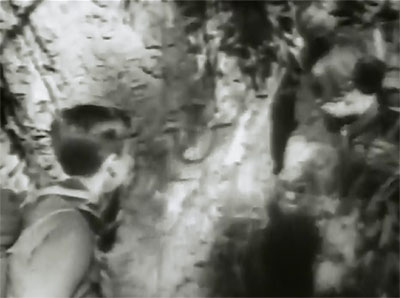
Above: Jim and Bobby find one of the treasure-trail marks.
Most of the serial’s “action” consists of such aimless ambling, or of similarly dull sequences; most of them are irrelevant to the main story (such as it is) and are shot in the flatly static and uninteresting visual style common to most independent serials, while all of them are interminably prolonged. One chapter (the fifth) spends nearly all of its entire seventeen-minute running time following the two Scouts as they dig up alligator eggs, play with a kinkajou, slowly ramble through the jungle in search of treasure markers, and walk into a cave–while another (Chapter Seven) devotes nearly eight minutes’ worth of footage to the Scouts sitting beneath a tree, talking about ghosts, looking at wildlife, and climbing into the tree after getting startled by a bird. Then there’s the protracted Chapter Eight scene in which Bobby changes his old shirt for a new one and watches alligators devour the cast-off garment, the subsequent scene in which the Scouts take a fish out of a snake’s mouth, the Chapter Ten scene in which the shady Condylos futilely tries to bargain with the natives who’ve captured him, the incredibly overlong sacrificial-dance ceremony in Chapter Two, and the equally dragged-out native dance in Chapter Six. The drum-beating that accompanies this dancing and some Boy Scout bugle-blowing in the first chapter constitute the only music on the serial’s soundtrack, aside from the opening-titles theme; the surpassing dullness of Eagles makes this absence of scoring far more noticeable than in any other similarly music-free serial of the period.
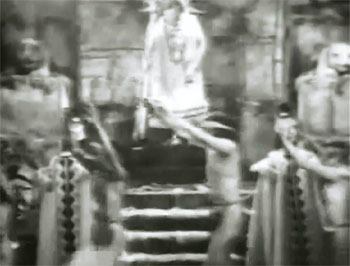

Above: Natives dance…and dance…and dance…(left) and Scouts sit…and sit…and sit…(right)
A lot of the dialogue in these scenes and many others (like the prattling about the dog Johnson and Bobby’s pudginess during the Chapter Nine canoe excursion) is so inane and pointless-sounding that I strongly suspect it was improvised; I can picture the directors glumly telling the cast members: “Just keep talking; we’ve got twelve good-sized chapters to fill here.” I say “directors” instead of “director” because three different men are credited with helming Eagles: the distinguished Spencer Bennet receives directorial credit in the trailer and in the first chapter, while Vin Moore (a director of silent comedy shorts who co-wrote three of Universal’s best pre-1936 serials) is billed on Chapters Two, Three, and Four. The remaining chapters bear the name of Edward Laurier, who has no other film credits of any kind. It seems more than likely that Bennet and Moore only shot a few scenes each, in order to give Romance a pretext for prominently plastering their names over the first three episodes–which would have been the episodes shown to theater owners in order to convince them to book the serial; the familiar monikers of Bennet and Moore would undoubtedly have hooked more unwary exhibitors than the unknown one of Laurier.
Eagles’ location work is one of its only assets; though some scenes are shot on soundstages, the bulk of the serial takes place in interesting outdoor locations, including the deeper and more heavily-foliaged areas of the forest at Lake Sherwood. I’d judge that some of the riverbank scenes were filmed at a zoo or alligator farm of some kind, mainly because of the number of non-stock-footage alligators shown swimming around in the “river” that’s featured throughout; I seriously doubt that so many reptiles would have been transferred to a movie ranch and then let loose there. Such rampant wildlife, along with the tree-shaded Sherwood terrain, really do manage to create the impression that the action is taking place in a jungle.

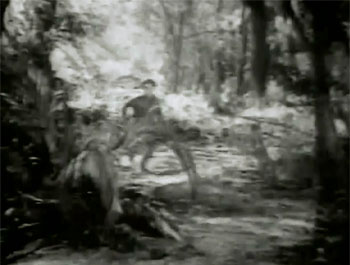
Above: An annoyed bull (left) pursues Bobby Cox (right) through a convincing stretch of “jungle.”
Eagles’ producers not only rounded up several live animals to appear in the chapterplay, but also seem to have taken pains to make sure that these animals (a tapir, spider monkeys, kinkajous, pumas, etc.) were native to the serial’s supposed Latin-American locale. Leopards do appear throughout, but are at least passed off as more geographically appropriate jaguars; even the raccoon that pops up to tussle with the dog Johnson could possibly exist in a jungle setting (the species extends all through Central America). A lot of the animal scenes fall into the category of padding, with the Scouts merely standing around, looking at the critters and making comments on them (and misidentifying a kinkajou as a bush-dog in one scene); however, they do interact with the big cats and the gators on occasion–usually either fleeing from them in panic or trying to beat them off with sticks.


Above left: The Scouts (not clearly visible) peer out of the bushes at a tapir. Above right: Bobby Cox cuddles a kinkajou–identified correctly in this scene, which makes the (later) bush-dog bit very puzzling.
These occasional (and typically short) interactions between Scouts and animals are the closest thing to action scenes to be found in the serial. The genuinely frightening mass alligator attack on the raft at the end of Chapter One is the best of the bunch, although Bobby’s headlong flight through the woods from a maddened bull in Chapter Ten (pictured above) is fine too; in this scene, and in the very brief one in which Bobby routs a “jaguar” with a stick, the beasts actually seem to be sharing the screen with the human players. The worst animal-hazard scene in the one at the beginning of Chapter Four, in which the boys try to climb out of a pit-trap while the jaguar trapped with them tries to claw out of a net; the sequence should be tense and gripping, but–like so many other scenes in the serial–is paced and shot so lethargically (and acted so poorly; the boys behave as if they have all the time in the world to escape) that it falls flat.


Above: Alligators lunge ferociously ,and tip over Bobby Cox and his raft at the end of Chapter One.
As you can deduce, all of the above-mentioned scenes figure either as cliffhangers or cliffhanger resolutions; after the first episode (which features a tepid cliffside rescue several minutes in, and a short clash with an alligator at its midway point), virtually all action takes place at the endings or beginnings of episodes. Most of the animal cliffhangers, and a couple of non-animal cliffhangers (like the Chapter Four suspension-bridge collapse), retain a little excitement value despite indifferent editing–and despite the jarring high-pitched shrieks with which the two young “heroes” react to nearly every peril. However, other chapter endings (several of them good in conception) are completely flattened by the tiresome way in which they’re handled–particularly Jim’s Chapter Two plunge down a sacrificial well (which comes as a relief rather than a shock, since it finally puts an end to the natives’ seemingly endless sacrificial dance), his Chapter Six immolation in a hut (which is preceded by more dancing and by monotonous and redundant shots of the burning native village), and Jim and Bobby’s burying by an exploded temple at the end of Chapter Eleven (the footage of the temple’s collapse–presumably stock–is impressive, but said collapse is preceded by a laughably static and drawn-out “suspense” shots of a fuse slowly burning down).

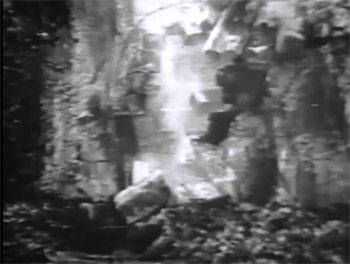
Above: The fuse at left burns away for almost three full minutes before finally setting off the striking explosion at right.
The cast of Eagles is top-lined by youngsters Bobby Cox and Jim Vance, both of them obviously inexperienced amateurs–but both of them forced to carry most of the serial’s scenes on their own. They deliver their lines in flat and careless style, sport slightly confused and slightly embarrassed facial expressions for much of the serial, and come off as awkwardly stiff when they try to convey sorrow or cheerful enthusiasm; even their panicked screams sound rather forced. Cox is slightly more energetic than Vance, however–which is possibly why the former, despite a chubbiness that would seem to mark him as a comic-relief character, is actually allowed to perform more heroics than the latter is (as a result, Vance’s occasional fat jokes at his co-hero’s expense wind up sounding like ungrateful and jealous belittlement, not friendly kidding). Johnson the dog, a cute-looking little pup, comes off as much more comfortable before the camera than either of the two “stars”–understandably, since he doesn’t have to deliver any dialogue.
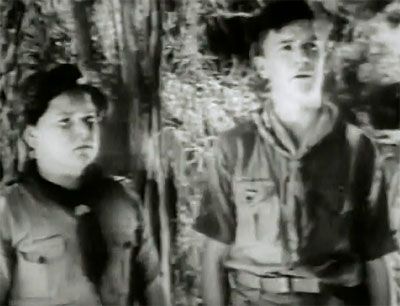
Above: Bobby Cox and Jim Vance.
As pilot Angus McLean, Carter Dixon (from his accent either British or Canadian) seems to be a reasonably competent actor, albeit a very bland one; his character also has almost nothing to do but stagger around the jungle in a pop-eyed, feverish haze. As the slippery jungle con-man Nicholas Condylos, frequent Mascot and Universal heavy Philo McCullough brings some actual charisma to the serial when he finally appears in Chapter Nine; though much of his dialogue is emptily repetitious and his indeterminate foreign accent is pretty ridiculous-sounding, the buoyantly hammy relish with which he plays his part comes as a very welcome change from the inept and lackluster performances of Cox and Vance. Merrill McCormick, a frequent and versatile player of background “ethnic” roles, portrays the bandit chief Jose Pinardo, and sounds more convincingly Latin than McCullough does–but also receives even less screen time, and is much more low-key and forgettable an actor.


Above left: Carter Dixon, somewhat the worse for wear, stares at jungle will-o-the-wisps. Above right: Merrill McCormick (left) and Philo McCullough confer.
Few other actors in Eagles have more than one or two scenes; Iron Eyes Cody can be spotted as a hostile Indian, Jules Cowles (who had a major role as the old trapper in Heroes of the West) plays one of McCormick’s bandits, and Earl Dwire gasps and groans very theatrically as the dying explorer who gives the Scouts the map that starts them on their treasure hunt. A blank-sounding player named Bob Ferrey (obviously a non-professional actor) appears as a friendly Indian guide; other roles (Boy Scouts, peasants, police officials) are played by similarly amateurish and unfamiliar “actors.” Frank Lackteen is sometimes credited as playing one of the unfriendly Indians in Eagles, but if he does he has no lines and stays in the background–which makes his participation in the serial seem highly unlikely; considering his status as a well-known chapterplay heavy, he’d almost certainly have been given a speaking part if he’d worked on Eagles, particularly since most of the supporting cast is so undistinguished.
Most serial buffs have traditionally ranked Young Eagles as the worst talking chapterplay ever made, and I’m inclined to agree with this assessment. There are serials that are almost as slow-moving and much more confusing, and serials that are even more cheaply-produced, but there are no other serials that manage to combine indifferent production values, a weak plot, poor dialogue, glacial pacing, a dearth of action scenes, and talentless, personality-free stars; its authentic animals and outdoor locations are just not enough to compensate for this deadly mixture of flaws. The theater-owner who issued the following trade-publication warning, not long after Young Eagles’ original release, summed the disastrous production up very accurately–and far more succinctly than I have:
“If you have bought this serial, pay for it and forget it, for it will ruin your business. Have played six episodes. It started out bad and gets worse each week. No cast, no story, no nothing but just a lot of film wasted.”
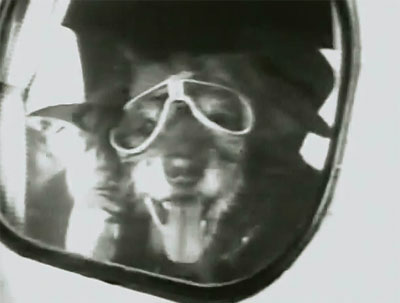
Well, at least Johnson seems to be having fun.
Acknowledgements: I obtained the above trade-paper excerpt from Book Two of the late Raymond William Stedman’s The Movie Serial Companion, where it’s quoted as part of that book’s Young Eagles entry.
Well, Jerry, you finally did it, you hit rock bottom, you watched YOUNG EAGLES. Actually, there are about seven serials that are a lot harder chore to sit through than this one. I have always said that QUEEN OF THE JUNGLE is much worse with about the entire serial filmed on a sound stage. The two things that interested me about YOUNG EAGLES were the location work, and the feeling that these two boys really were in deep trouble lost in a wild jungle.
You are probably correct about Bennet and Moore directing only a few scenes each, because the entire serial has the same look. Someone I knew had a 16MM print of it, and showed me a couple of chapters summed it up as “A fat boy running through the jungle just doesn’t do it for me.”
Remember:
“They are going to throw you down the well, Jim. They are going to kill you Jim!”
Nowhere to go but up!
It’s possible to make out a good “worst-ever” case for Queen of the Jungle, The Lost City, and maybe some of the Weiss serials and a couple of the mid-1940s and mid-1950s Katzman Columbias–but I still would award the “crown” to Young Eagles–since all of those other contenders have a little more plot and action than it does, as well as a scattering of interesting aspects that make them worth watching at points: sometimes striking photography and Gabby Hayes’ performance in Lost City, the fascinating big-budget silent stock footage, some entertaining romantic banter, and an excellent performance by Reed Howes in Queen of the Jungle, the presence of a boatload of entertaining silent-film veterans in the Weiss serials, and the work of Charles King, Leonard Penn, Jack Ingram, and the other stellar Columbia stock-company members in the poorer Katzman outings. Eagles, on the other hand, has absolutely nothing going for it but the locations and the animals.
No comment. Seems like your review is more interesting than the serial!
This is a close call, but I’m giving it a slight edge over QotJ for the same reasons as Pa and because these guys actually went outdoors. Boring trumps irritating. Both should be classified as time best spent elsewhere. Stock footage and cheap sets (or equally bad, process screens) can still be overcome with a great story, mood, villain and an engaging cast. The Fighting Devil Dogs often shows its frugality but is one of my favorite serials.
Well, it could have been worse; they might have done 15 chapters instead of just 12. Have mercy!
I have enjoyed every one of the 6 episodes of Young Eagles shown so far and will continue to do so.